Jay wanted someone who voted for A to speak up. I did all my listening on hd650 headphones. The piano was not a cheap upright in the corner. It was a very good upright in a after hours place with people listening to good music and having a good time. Same could be said for clip 3. As to clip 1, not my favorite song from a second tier group.
The P95 has rise in FR from 700hz to 1700hz. This partially emulates the eq needed to match the hd650 to the new Harman headphone compensation curve. Below is a link to a video with Bob Katz, mastering engineer, and Tyll Herstens talking about this new curve.
Big Sound 2015 Bob Katz EQing Headphones with the Harman Target Response | InnerFidelity
Jay Reed
The P95 has rise in FR from 700hz to 1700hz. This partially emulates the eq needed to match the hd650 to the new Harman headphone compensation curve. Below is a link to a video with Bob Katz, mastering engineer, and Tyll Herstens talking about this new curve.
Big Sound 2015 Bob Katz EQing Headphones with the Harman Target Response | InnerFidelity
Jay Reed
Jeshi,
Are you saying that:
1) THD at -45dB rather than -50dB is obviously audible, and disliked?
(given that H2 is the 'nice' harmonic and the least audibly intrusive)
2) This small THD rise is More audible than the doubling of decay time above 2k, (B80 and 10F, in comparison to PS95), which is doubled or more? And which decays to a similar level?
My own listening experience (like Bob Richards referencing Guitar reverb) says this:
If my brain can hear the changes in reverb tone from repeat periods 0-10ms (phasing/flanging/chorusing side effects) and ALSO a change it envelope decay (number of repeats) from 1-2, up to 30 or more.
If my brain can do this, AND ignore the +/- 20 dB swings in and above the presence region, and severe driver borne THD on top of all that....
Doesn't that say that the decay envelope ( especially in the spectral distribution of decay) is actually far more pivotal in assigning "driver character" than driver THD which is all at -40dB or greater?
I don't believe anyone can hear the difference between -45 and -50dB H2 so distinctly- despite piano track (as always ) being the best way to listen for it.
(though id still take a Steinway over Yamaha myself)
Now that would be a test!
(THD audibility of H2, 3 and 5 in small incremental additions to a very low THD driver. )
So what I summarise as my opinion, is that seeking ultimate flatness of FR and ultimate low THD, is not as important as a very low decay time. (this all.assumes that X's CSD aren't garbage data)
And the above (personal conclusion) scares the hell out of me! That whole audiophool phrase: Natural sound over uniform response and low THD.
Its uncomfortable. But isn't it always, when held beliefs are shattered by (hopefully accurate) reality?
Are you saying that:
1) THD at -45dB rather than -50dB is obviously audible, and disliked?
(given that H2 is the 'nice' harmonic and the least audibly intrusive)
2) This small THD rise is More audible than the doubling of decay time above 2k, (B80 and 10F, in comparison to PS95), which is doubled or more? And which decays to a similar level?
My own listening experience (like Bob Richards referencing Guitar reverb) says this:
If my brain can hear the changes in reverb tone from repeat periods 0-10ms (phasing/flanging/chorusing side effects) and ALSO a change it envelope decay (number of repeats) from 1-2, up to 30 or more.
If my brain can do this, AND ignore the +/- 20 dB swings in and above the presence region, and severe driver borne THD on top of all that....
Doesn't that say that the decay envelope ( especially in the spectral distribution of decay) is actually far more pivotal in assigning "driver character" than driver THD which is all at -40dB or greater?
I don't believe anyone can hear the difference between -45 and -50dB H2 so distinctly- despite piano track (as always ) being the best way to listen for it.
(though id still take a Steinway over Yamaha myself)
Now that would be a test!
(THD audibility of H2, 3 and 5 in small incremental additions to a very low THD driver. )
So what I summarise as my opinion, is that seeking ultimate flatness of FR and ultimate low THD, is not as important as a very low decay time. (this all.assumes that X's CSD aren't garbage data)
And the above (personal conclusion) scares the hell out of me! That whole audiophool phrase: Natural sound over uniform response and low THD.
Its uncomfortable. But isn't it always, when held beliefs are shattered by (hopefully accurate) reality?
Last edited:
Kool I never knew that headphones should have a weird response like this to be optimal. Thanks for sharing and for sticking your ground about how you felt the driver A sounded.
Jay wanted someone who voted for A to speak up. I did all my listening on hd650 headphones. The piano was not a cheap upright in the corner. It was a very good upright in a after hours place with people listening to good music and having a good time. Same could be said for clip 3. As to clip 1, not my favorite song from a second tier group.
The P95 has rise in FR from 700hz to 1700hz. This partially emulates the eq needed to match the hd650 to the new Harman headphone compensation curve. Below is a link to a video with Bob Katz, mastering engineer, and Tyll Herstens talking about this new curve.
Big Sound 2015 Bob Katz EQing Headphones with the Harman Target Response | InnerFidelity
Jay Reed
That's cool.
The biggest peak between 1 and 2 KHz sounds more distorted, so more in line with the reference? That's A, on the graph. But the B80 is the lowest
That's not what I said...
I said F and [then] A is the closest to reference in tonality [most of the time]. But of course not in all segment. In drum and cymbals of clip 2 at 0:25 if I'm not mistaken, 10F is simply the best and the closest to reference. Clip 2 [jazz] belongs to 10F. But clip 3? I don't think so. Even TG9 can be better than 10F, depends on preference or taste [which also depends on the audio system used].
The peak between 1k and 2k can be perceived as distortion. That's what happen with A [Dayton] and B [TG9] and even the reference.
TC9 had the lowest peak in total bandwidth. The attenuated peaks, especially in the critical band, has made this driver to be perceived as having low distortion by some listeners [including Jeshi who thought it was 10F and one of the best]. The side effect is that the music sounded closed in, miniature, compressed, less dynamic, unmusical. These negative traits have big effect if you listen casually [as in enjoying the music] without trying to zoom into detail.
Later may be I will show you something regarding this "peak" issue.
Regarding To Peak
Wesayso,
I'm not going to discuss this in detail... I'm just trying to give some hints...
Look at the attached picture regarding "track gain" and "track peak"...
Foobar has a feature to adjust gain such that the available peak doesn't clip the music. From the picture, what can you say about the files in clip 3? I'm not going to discuss it 🙂
The maximum peak for each file doesn't have to be on the same frequency. You can surely track them if you want. F has highest extreme peak but I believe it is in low frequency [surprised?]. B on the other hand, my ears say it is in the sensitive-to-ear band.
Wesayso,
I'm not going to discuss this in detail... I'm just trying to give some hints...
Look at the attached picture regarding "track gain" and "track peak"...
Foobar has a feature to adjust gain such that the available peak doesn't clip the music. From the picture, what can you say about the files in clip 3? I'm not going to discuss it 🙂
The maximum peak for each file doesn't have to be on the same frequency. You can surely track them if you want. F has highest extreme peak but I believe it is in low frequency [surprised?]. B on the other hand, my ears say it is in the sensitive-to-ear band.
Attachments
If anyone is curious I made a new series of distortion measurements on my 10f/8424 in a small sealed EVA foam box and posted them here
http://www.diyaudio.com/forums/full...rmance-speaker-enclosures-15.html#post4454303
Driver is running full range, single driver in a sealed box. no crossover, no woofer no FAST. A baffle step correction and a bessel 80hz rolloff for protection.
Tests are at 84db, 86db, 88db, 90db and 95db measured SPL at 0.5m
The cursor is placed at 1khz so the numbers in the legend correspond to the 1khz mark.
-12db input 84db at 0.5m
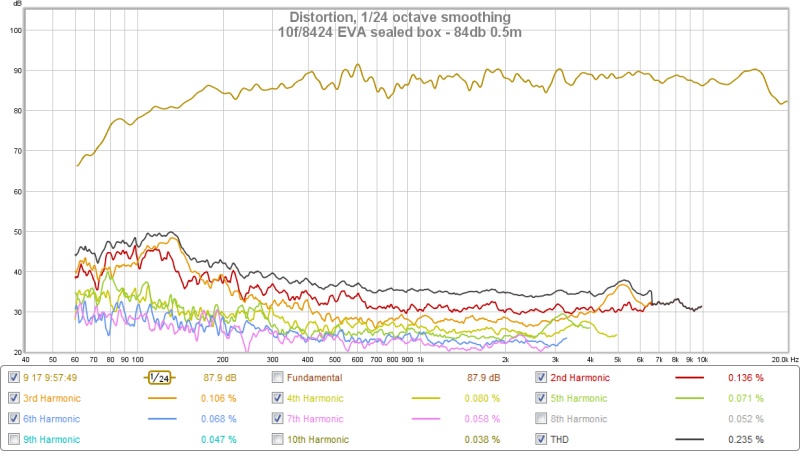
-10db input 86db at 0.5m
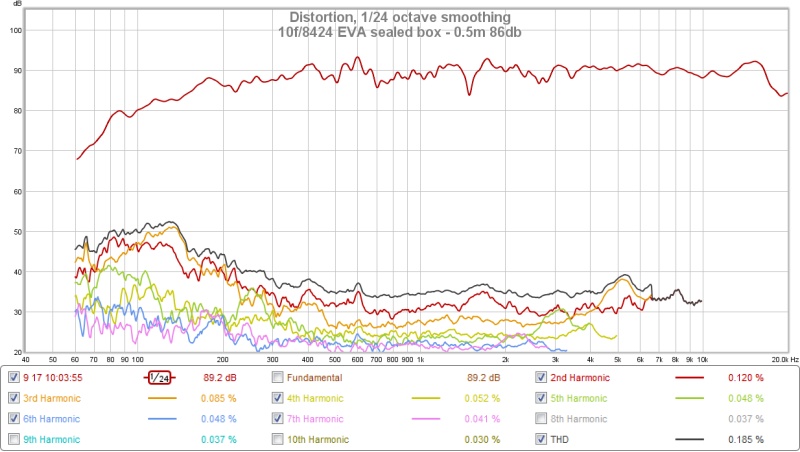
-9db input 88db at 0.5m
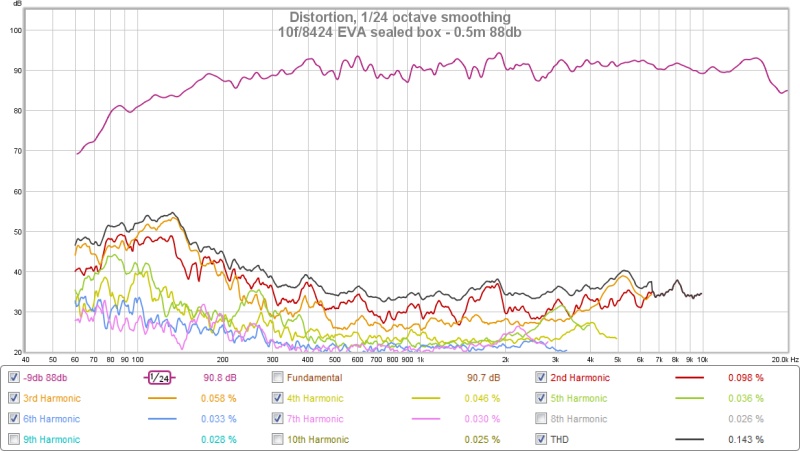
-6db input 90db at 0.5m
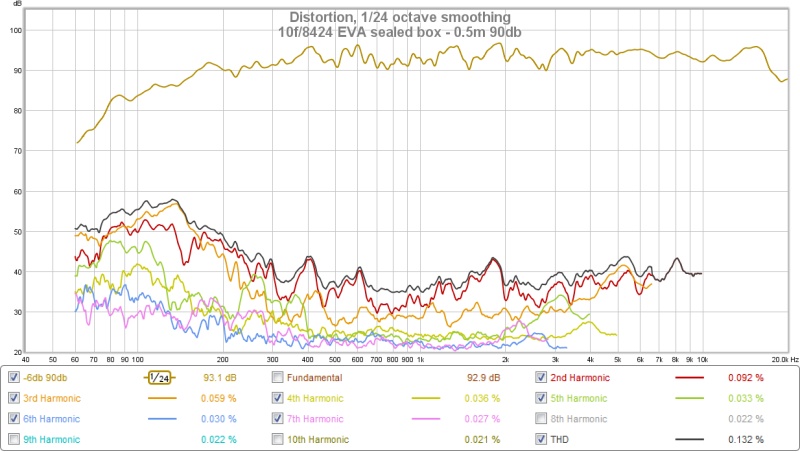
0db input 95db at 0.5m
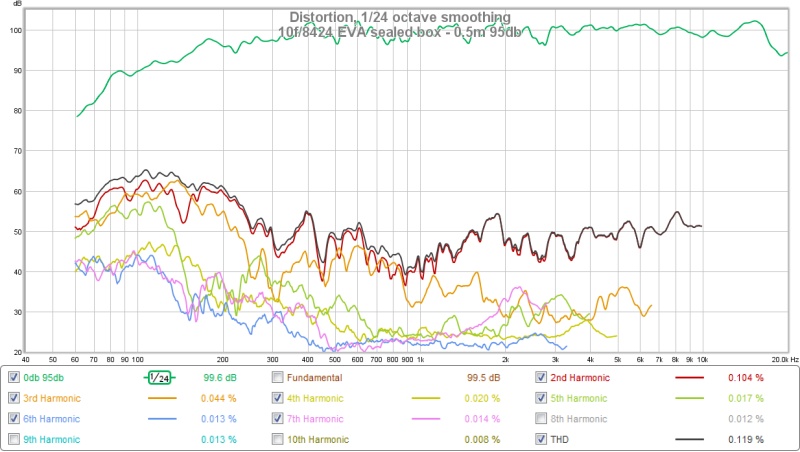
http://www.diyaudio.com/forums/full...rmance-speaker-enclosures-15.html#post4454303
Driver is running full range, single driver in a sealed box. no crossover, no woofer no FAST. A baffle step correction and a bessel 80hz rolloff for protection.
Tests are at 84db, 86db, 88db, 90db and 95db measured SPL at 0.5m
The cursor is placed at 1khz so the numbers in the legend correspond to the 1khz mark.
-12db input 84db at 0.5m

-10db input 86db at 0.5m

-9db input 88db at 0.5m

-6db input 90db at 0.5m

0db input 95db at 0.5m

Last edited:
If anyone is curious I made a new series of distortion measurements on my 10f/8424
<snip>
0db input 95db at 0.5m
Wow, so 10F distortion below 300Hz [even tho that where the XO is] is real like I have perceived on my main speaker...
Tho I'm not sure if it is what I heard. I suspected it was amplifier related. Compared with TG9, I perceived TG9 to have lower distortion in my system.
Last edited:
Wow, so 10F distortion below 300Hz [even tho that where the XO is] is real like I have perceived on my main speaker...
Tho I'm not sure if it is what I heard. I suspected it was amplifier related. Compared with TG9, I perceived TG9 to have lower distortion in my system.
jay, my 10f/8424 is running fullrange without a woofer/FAST. So it is very different from X's test.
Here is my 10f/8424 (in my sealed box) with an LR2 350hz crossover (to simulate what X's system might look like if he recorded without the RS225 woofer). I just ran this one at -6db input / 90db output at 0.5m
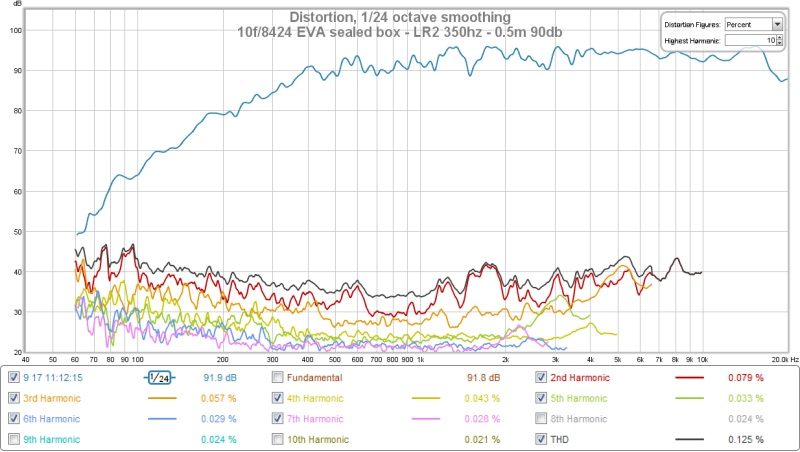
Attachments
I'm thinking that the 10F and the TG9 were the best drivers from the last round, since they had the least abrupt FR changes anywhere in frequency.
If you look at my previous Foobar attachment and understand driver difference in "gain" and "peak", you will see that you don't need to hear the sound in order to know what people preference will be. And yes, macroscopically all of these can be seen from FR flatness [But frequency response is not the only thing, so there can be trade off]
jay, my 10f/8424 is running fullrange without a woofer/FAST. So it is very different from X's test.
Yes I knew that. I have some thresholds regarding driver's non linear distortion. And this driver [and I think all others] are all okay above 300Hz. But there is something else regarding how much dB down, or how fast the roll off should be for those distortion peak.
Last night I compared TG9 and 10F in my system. 10F appeared to be more fatiguing at low frequency with clip 3. Clip 3 is the hardest for all drivers, and especially for 10F. That percussion has strong impact [which is typical of transient perfect crossover]...
The perceived sound is as if the speaker doesn't have the capability to reproduce the bass, back EMF or the amplifier doesn't have enough "drive" or having too high output impedance that when driving difficult load reproduce the bass signal with high distortion...
My first prediction is that it is an amplifier problem. The Gainclone has lower gain than specified in the suggested application in the pdf, and I run the amp with only +/-15 volt supply. If increasing the supply voltage and gain doesn't fix this, I will change the speaker [It was a new temporary design].
Last edited:
10F/8424 harmonic distortion meas in Dagger
To give a comparison with Jeshi's measurements of the 10F in her EVA foam enclosures, I made similar measurements in the Dagger used for this Round 4.
I did it "full range" with just an 80Hz Bessel (2nd order) in miniDSP. I set the gain to 0dB inside miniDSP and adjusted the drive voltage from REW to get the various SPL's. I also did a second set with the same XO filter used for the Harsch XO in these measurements: a 350Hz Bessel (2nd order). I also did some measurements without any baffle step compensation and also with a -4dB high shelf at 900Hz and Q=0.5.
The values for the HD in the legend is for the cursor set at 1kHz.
Low SPL 86dB at 0.5m, with BSC, and full range 80Hz HPF (ignore 3 peaks below 150Hz - those are HVAC noise peaks):
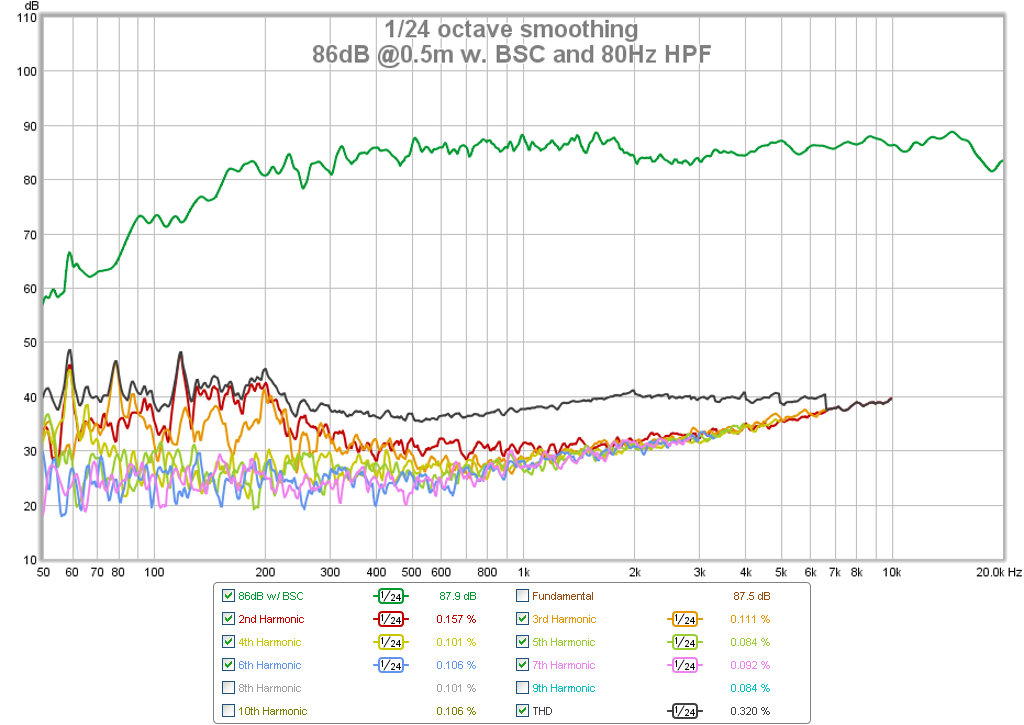
Moderate SPL 96dB at 0.5m, with BSC and 80Hz HPF:
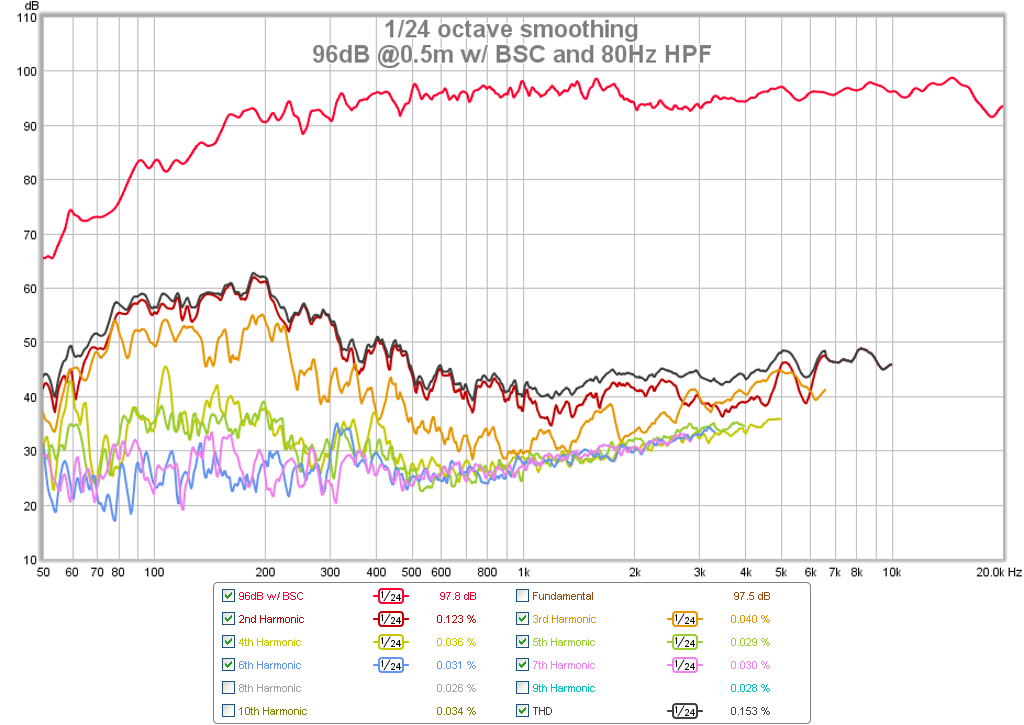
Moderate SPL 96dB at 0.5m, with BSC and 350Hz HPF:
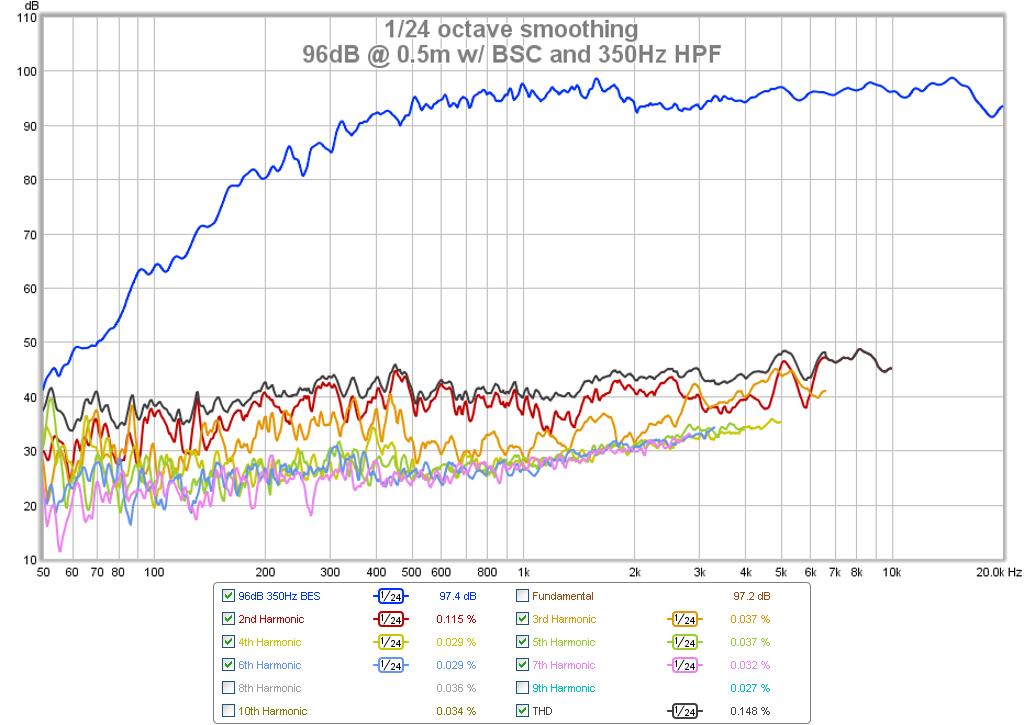
High SPL 100dB at 0.5m, with BSC and 350Hz HPF:
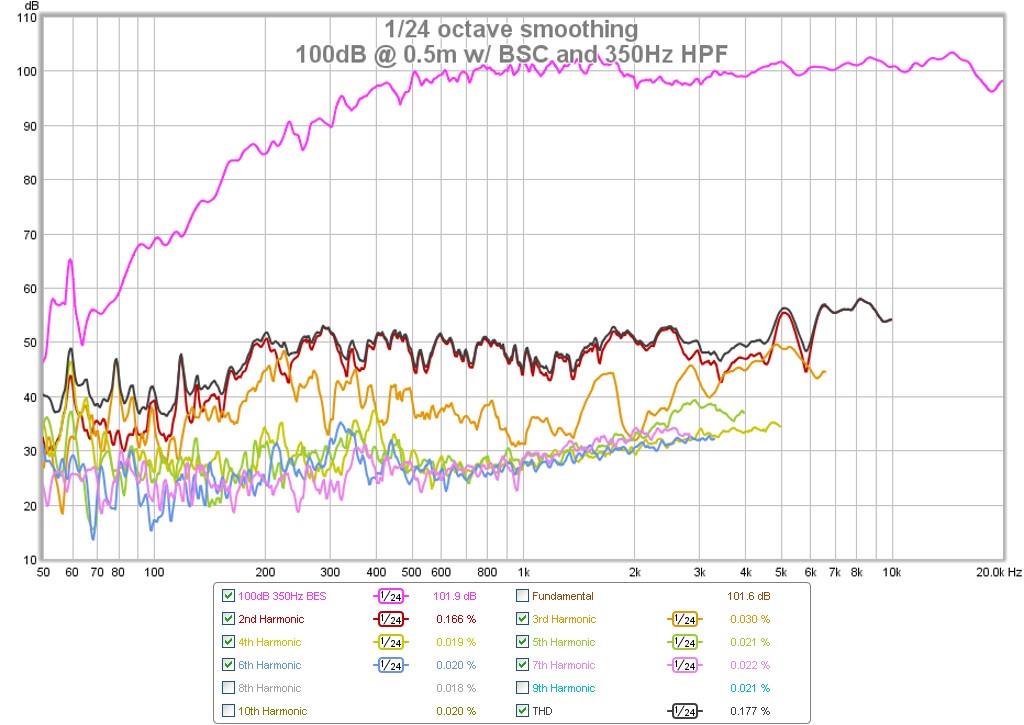
For comparison, here is what 100dB and 80Hz HPF without BSC looks like:
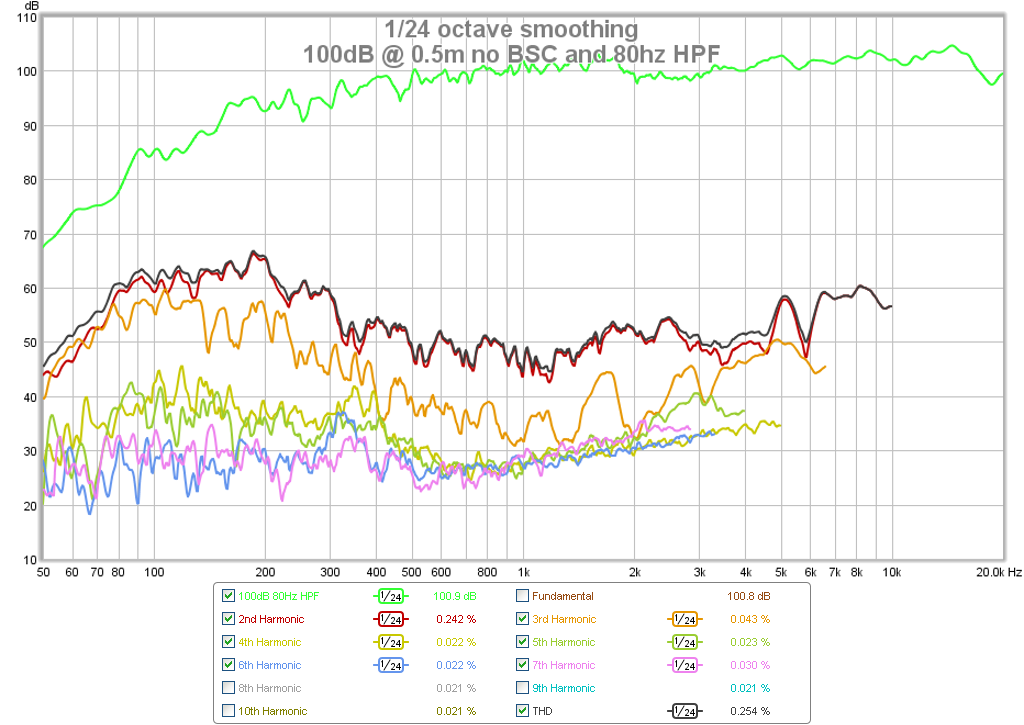
I think these measurements resemble Jeashi's although I think the 1.13 liter volume Dagger stuffed with fiberglass may be exhibiting lower HD. It may also be a combination of lower noise mic with built in pre-amp at the mic.
I am getting 0.177% THD at 100dB and 1000 Hz, this is the same as SPL of 94dB at 1m.
The main point is that HD is not an issue near or below the 350Hz XO point with the Bessel HPF in place.
To give a comparison with Jeshi's measurements of the 10F in her EVA foam enclosures, I made similar measurements in the Dagger used for this Round 4.
I did it "full range" with just an 80Hz Bessel (2nd order) in miniDSP. I set the gain to 0dB inside miniDSP and adjusted the drive voltage from REW to get the various SPL's. I also did a second set with the same XO filter used for the Harsch XO in these measurements: a 350Hz Bessel (2nd order). I also did some measurements without any baffle step compensation and also with a -4dB high shelf at 900Hz and Q=0.5.
The values for the HD in the legend is for the cursor set at 1kHz.
Low SPL 86dB at 0.5m, with BSC, and full range 80Hz HPF (ignore 3 peaks below 150Hz - those are HVAC noise peaks):

Moderate SPL 96dB at 0.5m, with BSC and 80Hz HPF:

Moderate SPL 96dB at 0.5m, with BSC and 350Hz HPF:

High SPL 100dB at 0.5m, with BSC and 350Hz HPF:

For comparison, here is what 100dB and 80Hz HPF without BSC looks like:

I think these measurements resemble Jeashi's although I think the 1.13 liter volume Dagger stuffed with fiberglass may be exhibiting lower HD. It may also be a combination of lower noise mic with built in pre-amp at the mic.
I am getting 0.177% THD at 100dB and 1000 Hz, this is the same as SPL of 94dB at 1m.
The main point is that HD is not an issue near or below the 350Hz XO point with the Bessel HPF in place.
Attachments
Last edited:
mondogenerator, thanks for your comments
I guess I should have been more precise. If the THD at my normal listening level (~90db) is what is shown in these plots, then I agree that the difference between -45db and -50db is nothing. What I worry about is that these HD bumps at low SPL levels (like X recorded at) might blow up to a -30db or -20db level when playing at normal to loud levels. I was just voicing a concern, and pointing out a difference that did not show up in the 10f/8424 (which I already own).
My problem is that I can't ignore strange swings in frequency response. It really irritates me and I have many times listened to a speaker, or someones track mix and knew immediately that it is off. Part of this is training for my second job (mixer,producer,composer), part of this was something I picked up just playing woodwind and string instruments (knowing if I am playing a note in tune and with the right tone) and part from listening to lots of acoustic music over the years. I envy you that you can ignore FR anomalies and appreciate the underlying good spectral decay and low distortion of a speaker. I can't do that. A speaker first has to have a flat FR before I can listen to it and then appreciate its other qualities.
And I do agree that spectral decay is important. I just haven't figured out personally if low distortion, fast transients, fast spectral decay, minimal ring overshoot or other known measurements correlates with when a speaker sound great to me.
You make a good point here that low decay times might be more important than previously considered. But I also know that unless we are in an acoustically treated room, that the room will create time decay smearing as dominant as (or more than) the native 5msec decay/ringing of the drivers. I do know that I love the sound of electrostatic speakers and headphones which have incredibly fast transient attack and decay times.
And I hope my comments did not offend anyone that voted for the PS95. That was not my intention. I was just trying to explain my process in more detail of why the PS95 ("A" recordings) gave a marmite "no" response to me. I can't buy every single driver ever tested here, and I don't want to have a large box of "drivers I don't like". To me these listening tests are to help us narrow down the driver which we personally might enjoy at home. My preference is not your preference.
OK I will give the PS95 tracks another listen. I can EQ the recordings flat and then listen again and see if I can hear the fast decays that you are referring to. Is there any particular track where the best qualities of the PS95 shined out for you so that I can try to hear what you heard?
Jeshi,
Are you saying that:
1) THD at -45dB rather than -50dB is obviously audible, and disliked?
(given that H2 is the 'nice' harmonic and the least audibly intrusive)
2) This small THD rise is More audible than the doubling of decay time above 2k, (B80 and 10F, in comparison to PS95), which is doubled or more? And which decays to a similar level?
I guess I should have been more precise. If the THD at my normal listening level (~90db) is what is shown in these plots, then I agree that the difference between -45db and -50db is nothing. What I worry about is that these HD bumps at low SPL levels (like X recorded at) might blow up to a -30db or -20db level when playing at normal to loud levels. I was just voicing a concern, and pointing out a difference that did not show up in the 10f/8424 (which I already own).
My own listening experience (like Bob Richards referencing Guitar reverb) says this:
If my brain can hear the changes in reverb tone from repeat periods 0-10ms (phasing/flanging/chorusing side effects) and ALSO a change it envelope decay (number of repeats) from 1-2, up to 30 or more.
If my brain can do this, AND ignore the +/- 20 dB swings in and above the presence region, and severe driver borne THD on top of all that....doesn't that say that the decay envelope ( especially in the spectral distribution of decay) is actually far more pivotal in assigning "driver character" than driver THD which is all at -40dB or greater?
My problem is that I can't ignore strange swings in frequency response. It really irritates me and I have many times listened to a speaker, or someones track mix and knew immediately that it is off. Part of this is training for my second job (mixer,producer,composer), part of this was something I picked up just playing woodwind and string instruments (knowing if I am playing a note in tune and with the right tone) and part from listening to lots of acoustic music over the years. I envy you that you can ignore FR anomalies and appreciate the underlying good spectral decay and low distortion of a speaker. I can't do that. A speaker first has to have a flat FR before I can listen to it and then appreciate its other qualities.
And I do agree that spectral decay is important. I just haven't figured out personally if low distortion, fast transients, fast spectral decay, minimal ring overshoot or other known measurements correlates with when a speaker sound great to me.
So what I summarise as my opinion, is that seeking ultimate flatness of FR and ultimate low THD, is not as important as a very low decay time. (this all.assumes that X's CSD aren't garbage data)
And the above (personal conclusion) scares the hell out of me! That whole audiophool phrase: Natural sound over uniform response and low THD.
Its uncomfortable. But isn't it always, when held beliefs are shattered by (hopefully accurate) reality?
You make a good point here that low decay times might be more important than previously considered. But I also know that unless we are in an acoustically treated room, that the room will create time decay smearing as dominant as (or more than) the native 5msec decay/ringing of the drivers. I do know that I love the sound of electrostatic speakers and headphones which have incredibly fast transient attack and decay times.
And I hope my comments did not offend anyone that voted for the PS95. That was not my intention. I was just trying to explain my process in more detail of why the PS95 ("A" recordings) gave a marmite "no" response to me. I can't buy every single driver ever tested here, and I don't want to have a large box of "drivers I don't like". To me these listening tests are to help us narrow down the driver which we personally might enjoy at home. My preference is not your preference.
OK I will give the PS95 tracks another listen. I can EQ the recordings flat and then listen again and see if I can hear the fast decays that you are referring to. Is there any particular track where the best qualities of the PS95 shined out for you so that I can try to hear what you heard?
Last edited:
Jeshi,
So what I summarise as my opinion, is that seeking ultimate flatness of FR and ultimate low THD, is not as important as a very low decay time. (this all.assumes that X's CSD aren't garbage data)
And the above (personal conclusion) scares the hell out of me! That whole audiophool phrase: Natural sound over uniform response and low THD.
Its uncomfortable. But isn't it always, when held beliefs are shattered by (hopefully accurate) reality?
Well could be true, however as Jeshi wrote. If one doesn't have full room treatment, the peaks in loudspeaker could coincide with room modes, dips, wife shouting😀 and make it simply unbearable. I had that experience since before…..
Peter
Drivers recorded at 0,5 meter on axis except PS95-8 which was at 30º off axis.
Drivers measured at 0,5 meter on axis, does that also include PS95-8 or is it measured 30º off axis i asked in post 519.
Would be nice to have answered because it will mean if we can correlate PS95-8 sound from clips to the traces in the plots and also if PS95-8 actual measured 30º off axis think will give a different CSD coused by microphone relative softer angle to baffle reflection and diffraction.
Drivers measured at 0,5 meter on axis, does that also include PS95-8 or is it measured 30º off axis i asked in post 519.
Would be nice to have answered because it will mean if we can correlate PS95-8 sound from clips to the traces in the plots and also if PS95-8 actual measured 30º off axis think will give a different CSD coused by microphone relative softer angle to baffle reflection and diffraction.
Last edited:
I'm thinking that the 10F and the TG9 were the best drivers from the last round, since they had the least abrupt FR changes anywhere in frequency. All other drivers had a significant abrupt FR change in one place and/or another.
I think I preferred that setup for the full range drivers (round 2) to the one in round 4. I believe the Dagger enclosure didn't bring out the best in all the drivers while the Nautaloss acted more like the driver would do if mounted on a baffle.
Drivers recorded at 0,5 meter on axis except PS95-8 which was at 30º off axis.
Drivers measured at 0,5 meter on axis, does that also include PS95-8 or is it measured 30º off axis i asked in post 519.
Would be nice to have answered because it will mean if we can correlate PS95-8 sound from clips to the traces in the plots and also if PS95-8 actual measured 30º off axis think will give a different CSD coused by microphone relative softer angle to baffle reflection and diffraction.
Both measurement and and sound recorded at 30deg off axis.
Both measurement and and sound recorded at 30deg off axis.
Thanks and great then frq response traces correlate to sound clip and guess PS95-8 real on axis response will be close to plots showed at round 1 with precaution round 1 verse round 4 had not same baffle/woofer setup.
What do you think about CSD then can we question if decay and counted slices would be different and better if 10F or the other drivers was measured at 30º off axis because of softer angle to baffle reflection and diffraction, or PS95-8 be worse if CSD taken on axis 0,5 meter. The mic angle to baffle/drivers is a variable those CSD plots between.
Last edited:
X,
Could you provide SPL at .5m with speaker terminal voltage as a reference for 10f. This will allow me to reference my drivers to yours.
Could you provide SPL at .5m with speaker terminal voltage as a reference for 10f. This will allow me to reference my drivers to yours.
- Home
- Loudspeakers
- Full Range
- A Subjective Blind Comparison of 2in to 4in drivers - Round 4







